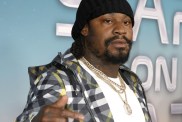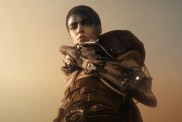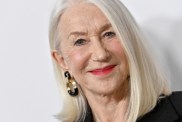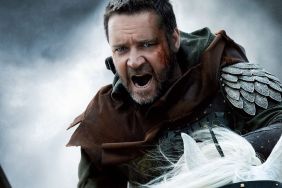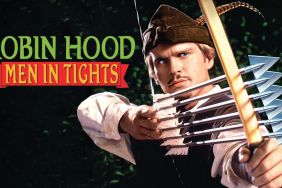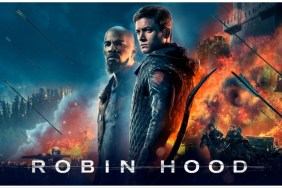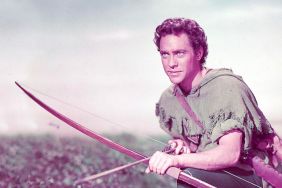Robin Hood: 8.5 out of 10
Prince of Persia: The Sands of Time: 6 out of 10
“Robin Hood” Cast:
Russell Crowe as Robin Longstride
Cate Blanchett as Marion Loxley
Max von Sydow as Sir Walter Loxley
William Hurt as William Marshal
Mark Strong as Godfrey
Oscar Isaac as Prince John
Danny Huston as King Richard The Lionheart
Eileen Atkins as Eleanor of Aquitaine
Mark Addy as Friar Tuck
Matthew Macfadyen as Sheriff of Nottingham
Kevin Durand as Little John
Scott Grimes as Will Scarlet
Alan Doyle as Allan A’Dayle
Douglas Hodge as Sir Robert Loxley
Léa Seydoux as Isabella of Angoulême
Directed by Ridley Scott
“Prince of Persia” Cast:
Jake Gyllenhaal as Dastan
Gemma Arterton as Tamina
Ben Kingsley as Nizam
Alfred Molina as Sheik Amar
Steve Toussaint as Seso
Toby Kebbell as Garsiv
Richard Coyle as Tus
Ronald Pickup as King Sharaman
Reece Ritchie as Bis
Gísli Örn Gar
Claudio Pacifico as Hassansin Porcupine
Thomas DuPont as Hassansin Whip Man
Dave Pope as Hassansin Giant Scimitar
Domonkos Pardanyi as Hassansin Double-Bladed Halberd
Massimilano Ubaldi as Hassansin Long Razor
Vladimir ‘Furdo’ Furdik as Hassansin Grenade Man
Directed by Mike Newell
Analysis:
While the summer months are normally seen as sequel season, this year seems to be more about remakes, relaunches and prequels to familiar properties, the first two of them harking back to the films of yesteryear, genres that have barely been seen on screen for twenty to thirty years or more. “Robin Hood” and “Prince of Persia: The Sands of Time” act as prequels to stories that some may be familiar with, whether it’s the books and movies for the former or the popular series of video games for the latter, and they’re daring for their approaches to the source material. The fact both movies open with a nearly identical raid on a castle is somewhat ironic, though they then go off in almost diametrically opposing directions in terms of tone.
“Robin Hood” is the story of archer Robin Longstride (Russell Crowe) who returns to England after the Crusades of King Richard (Danny Huston), pretending to be Robert Locksley, a dead soldier, in order to bring his sword back to his father (Max von Sydow) in Nottingham. Once there, he agrees to help the impoverished community while retaining the ruse by pretending to be married to Locksley’s widow Marion (Cate Blanchett). Meanwhile, France is planning a sneak attack invasion on England masterminded by Godfrey (Mark Strong), a friend of England’s newly-crowned King John (Oscar Isaac) who is in fact working for France’s King Phillip.
The hero of “Prince of Persia” is Jake Gyllenhaal’s Prince Dastan, adopted as a boy by the King of Persia but whose involvement in the raid of the Holy City of Alamut leads to conflict with his two brothers Tus and Garsiv, who don’t appreciate their grandstanding stepbrother. When Dastan’s adoptive father is murdered, the blame falls on Dastan, sending Dastan and the city’s Princess Tamina (Gemma Arterton), on a dangerous journey to keep an ornate dagger which grants the bearer the ability to travel back in time out of the hands of Dastan’s power-hungry family.
While there are many expectations involved with any movie called “Robin Hood,” Ridley Scott probably wasn’t setting out to retell stories we’ve already seen or heard before, instead creating the groundwork for a version of the story based in the reality of the times. This period of history is obviously something that interests Sir Ridley, as the story takes place chronologically almost immediately after his underrated Crusades movie “Kingdom of Heaven.” In that sense, Mel Gibson’s “Braveheart” is a far better comparative jumping-on point than “Gladiator,” the Roman epic that first united Scott with his charismatic leading man Russell Crowe. Screenwriter Brian Helgeland has created a complex story that takes some time to adjust to having so many characters introduced mid-battle, and it’s just about the history of the conflict between England and France than it is about how Robin Hood became the outlaw loved by the common people.
While “Prince of Persia” tries to instill similar political elements into its story, it comes across more like “Green Zone” in its attempt to mix elements that don’t necessarily work together. Set in a time period that’s somewhat more vague, it’s clearly learning further into straight fantasy territory, rather than worrying about any sort of historical accuracy. That might make some of the movie’s problems more forgivable but it’s always so obviously trying to be something else, whether it’s “Pirates of the Caribbean” or “The Mummy” … or rather “Raiders of the Lost Ark,” which the latter successfully plagiarized. Even with influences from some of the stronger summer popcorn movies, “Prince of Persia” just doesn’t work, maybe because it’s trying so hard to live up to those precedents.
Some may feel this review is the work of some sort of Ridley Scott apologist, but being that he’s one of the most consistent filmmakers in terms of realizing a vision with his craft, he once again directs the hell out of this movie even while deliberately taking an unconventional approach to the material. Not that Scott has completely forsaken all things we already know about Robin Hood, he just chooses to set the character in the context of a dark medieval war epic rather than as a light-hearted swashbuckling tale. Even so, there are plenty of familiar elements, his Merry Men bringing a suitable amount of levity with their proclivity for partying, a welcome break from the dark reality of the times.
Some may feel Russell Crowe is well and truly over by now, but he still proves himself to be a leading man well suited for this type of heroic role, as he’s able to maintain your attention even when he’s not fighting. Other than his questionable age, there are only brief glimpses of the Robin Hood we know because Crowe plays it completely serious allowing his men to get all the laughs. The same can’t really be said for Jake Gyllenhaal who seems completely out of place in the role of Dastan, unsure whether to retain a light playful tone throughout or take the dangers around him more seriously.
Both protagonists are bolstered by women who are clearly their equals, though comparing one of our greatest living actresses at the height of her ability to relative newcomer Gemma Arterton is somewhat futile and unfair. They both play feisty and fiery characters, tough enough to get directly involved in the action. Arterton is certainly a lot more pleasing to look at for an extended period of time than the deliberately glammed-down Cate Blanchett, but the latter gives a performance on par with her Queen Elizabeth, drawing parallels (for better or worse) to the story in “The Golden Age” sequel. The forced chemistry between Gyllenhaal and Arterton, meant to be awkward and tense due to their unwitting relationship, contributes to the problems because so much of the movie focuses on them, and their trading of jabs isn’t as much fun as it should be. By comparison, the burgeoning relationship between Robin and Marion is the type of memorable romance that defines classic cinema storytelling.
Where Scott’s vision thrives is in avoiding any grey area between good and evil with some suitably loathsome villains, the most impressive being Mark Strong’s Godfrey, a British turncoat working with the French by providing information he gets from the court of his friend King John (Oscar Isaac). Similarly, Isaac’s performance as the spoiled and arrogant John, playing him as a sniveling toadie who does everything he can to make you loathe him even as he tries to win the love of the people. His behavior allows Eileen Atkins to add to the strong women as his scolding mother trying to keep him in check as he spirals out of his control. Some may be disappointed that Matthew Macfadyen’s Sheriff of Nottingham is a relatively insignificant sideplayer who only makes his move towards becoming Robin’s foe towards the end.
Having directed the fourth installment of the “Harry Potter” series, Mike Newell has experience with big CG-laden action epics, but he’s better known for his skills at creating character dynamics by bringing strong performances out of his actors. Maybe that’s why the erratic performances in “Prince of Persia” is the most surprising, because we’ve seen far stronger work from the likes of Sir Ben Kingsley, Toby Kebbell et al. The excessive make-up and eyeliner worn by some of the male characters also makes it difficult to avoid making “Pirates” comparisons. The best part of “Prince of Persia” is Alfred Molina’s Sheik Amar, who brings a similar level of comic menace to Dastan’s journey as Geoffrey Rush did in “Pirates.” Along with his dagger-throwing African henchman Seso, they’re able to energize the movie whenever they’re on screen, and Molina’s interaction with an ostrich may be a comedic career high for the actor.
The battle sequences during the first and last twenty minutes of “Robin Hood” are on par with some of Scott’s best, his trademark visual techniques fully on display. The few times when we get to see Robin Hood wield his bow, the camera follows the arrow closely until it reaches its target. Not that “Robin Hood” is perfect, because the lengthy period spent in Nottingham is constantly in danger of turning into “Renaissance Faire: The Movie.” As action takes the backburner, Scott maintains the viewer’s interest by building tension with the character dynamics, the entire cast delivering some of their best work, particularly Max von Sydow, who steals many of the slower dialogue scenes. Scott’s attention to detail in creating this environment, including the politics of war, also makes the movie so fascinating.
Action certainly plays a consistently larger part in “Prince of Persia” with its well-choreographed Parkour chases and weapon-based fights that are sadly plagued by jarring editing that cuts too quickly for the human eye to keep up with. The visual FX are also cheesy at times, the time-reversing effect looking cool the first time we see it, but the CG working better when creating the impressive environments rather than the Sands of Time FX.
The movie’s biggest stumbling block is in trying to create a sense of danger while never getting very serious, and by the time our heroes are being attacked by flying CG snakes, the movie has lost any chance of coming back. It certainly would have benefited greatly from establishing itself more in some sort of reality in which the fantasy could thrive to make things seem more magical. Instead, the magic is handled in such a dull, matter of fact way that it detracts from the usual action-adventure excitement we’ve come to expect from Jerry Bruckheimer. If that’s not bad enough, the whole thing culminates in a disastrous bit of CG work.
By comparison, the enormous final beach battle in Scott’s film is one to marvel at with fantastic shots that seem to have been done all on location sans CG. It’s certainly a far more satisfying climax, one that’s only marred by a number of unfortunate moments that proves romance has no place on the battlefield. After that, it’s almost a letdown when the movie finally falls into familiar territory spending roughly five minutes establishing Robin Hood as the outlaw thief living in Sherwood Forest we all know.
Possibly the strangest revelation that arises by analyzing the two movies as a pair is that “Prince of Persia” was probably more influenced by Errol Flynn’s swashbuckling version of Robin Hood and Disney’s animated take on the character than Ridley Scott ever was. That’s not necessarily a bad thing for either movie. Bottom line is that Scott has created another masterful period piece of the highest caliber, one that gets your adrenaline pumping as it draws you into its story. Any attempt by the makers of “Prince of Persia” to create a magical fun adventure instead falls flat, ultimately turning into a convoluted mess that barely registers once the end credits roll.

